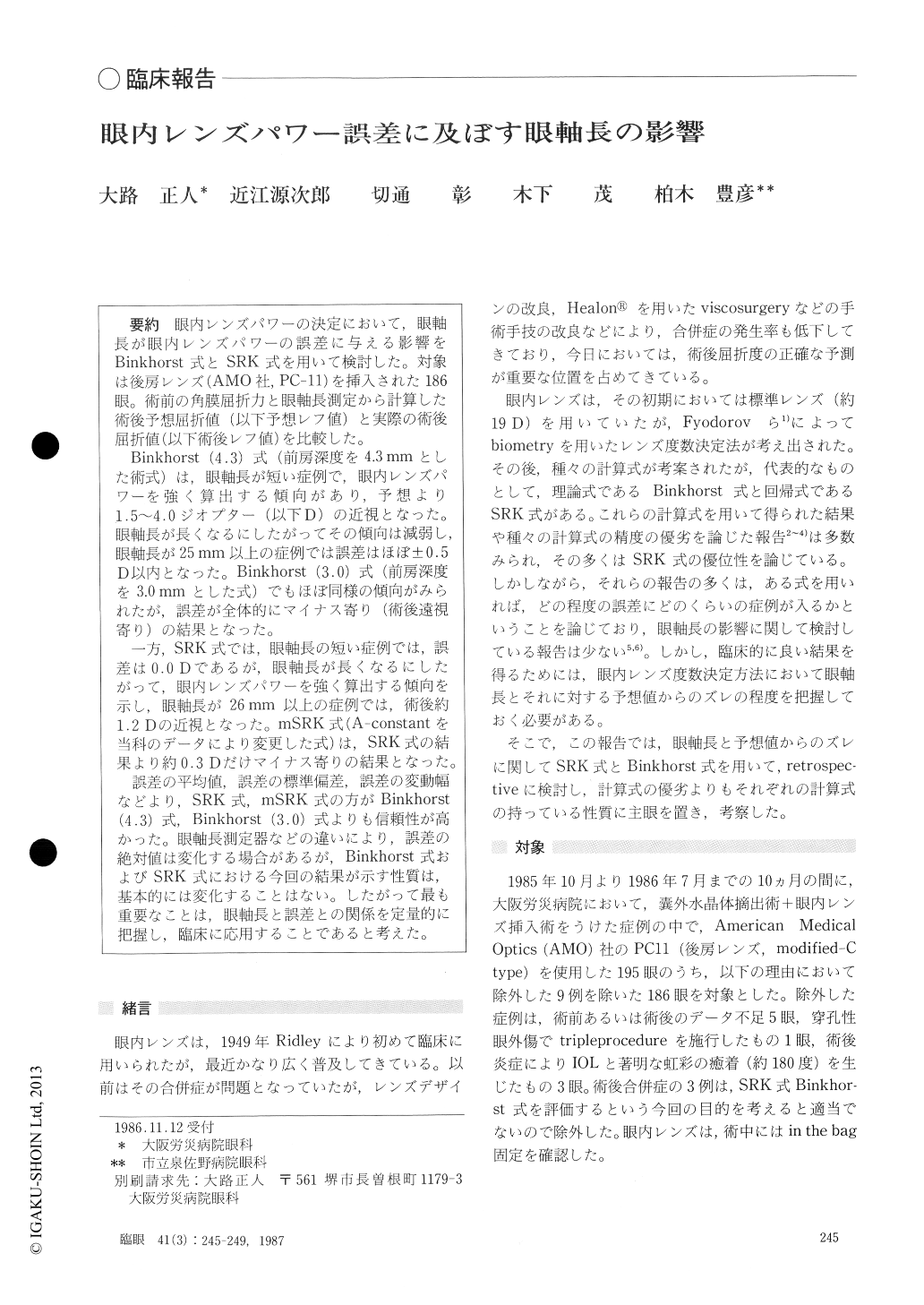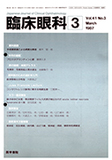Japanese
English
- 有料閲覧
- Abstract 文献概要
- 1ページ目 Look Inside
眼内レンズパワーの決定において,眼軸長が眼内レンズパワーの誤差に与える影響をBinkhorst式とSRK式を用いて検討した.対象は後房レンズ(AMO社,PC-11)を挿入された186眼.術前の角膜屈折力と眼軸長測定から計算した術後予想屈折値(以下予想レフ値)と実際の術後屈折値(以下術後レフ値)を比較した.
Binkhorst (4.3)式(前房深度を4.3mmとした術式)は,眼軸長が短い症例で,眼内レンズパワーを強く算出する傾向があり,予想より1.5〜4.0ジオプター(以下D)の近視となった.眼軸長が長くなるにしたがってその傾向は減弱し,眼軸長が25mm以上の症例では誤差はほぼ±0.5D以内となった.Binkhorst (3.0)式(前房深度を3.0mmとした式)でもほぼ同様の傾向がみられたが,誤差が全体的にマイナス寄り(術後遠視寄り)の結果となった.
一方,SRK式では,眼軸長の短い症例では,誤差は0.0Dであるが,眼軸長が長くなるにしたがって,眼内レンズパワーを強く算出する傾向を示し,眼軸長が26mm以上の症例では,術後約1.2Dの近視となった.mSRK式(A-constantを当科のデータにより変更した式)は,SRK式の結果より約0.3Dだけマイナス寄りの結果となった.
誤差の平均値,誤差の標準偏差,誤差の変動幅などより,SRK式,mSRK式の方がBinkhorst(4.3)式,Binkhorst(3.0)式よりも信頼性が高かった。眼軸長測定器などの違いにより,誤差の絶対値は変化する場合があるが,Binkhorst式およびSRK式における今回の結果が示す性質は,基本的には変化することはない。したがって最も重要なことは,眼軸長と誤差との関係を定量的に把握し,臨床に応用することであると考えた。
We evaluated the relationship between the axial length of the eye and the error of refraction after posterior intraocular lens (IOL) implantation in a consecutive series of 186 eyes. The error wasdefined as predicted postoperative refraction minus actual postoperative refraction. In predicting the power of IOL for each eye, we compared the Bink-horst's theoretical formula and SRK regression formula.
The SRK formula proved to be superior to Bink-horst's because of lesser average error, lesser stan-dard deviation and a smaller range of error between both extremes. When using Binkhorst's formula, there was a tendency for overcalculation of lens power, or tendency for postoperative myopia, for eyes with shorter axial length. The error averaged 4.1 D in 2 eyes with 20 mm in axial length. Thecalculated error decreased in eyes with larger axial lengths and fell within the range of 0.5 D in eyes with the axial length of 25 mm or more. According to the SRK regression formula, the average error was 0 D in eyes with 20 mm in axial length, to increase along with elongation of the axial length. It averaged 1.2 D in eyes with axial length of 26 mm or more.
Our findings indicate that the axial length in amajor source of error in determining the power of IOL before surgery and the both Binkhorst's and SRK formulas are of value under certain reserva-tions.
Rinsho Ganka (Jpn J Clin Ophthalmol) 41(3) : 245-249, 1987

Copyright © 1987, Igaku-Shoin Ltd. All rights reserved.


